

Melons
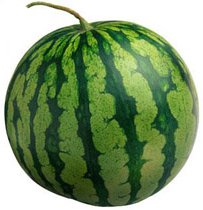
The sweet melon (Cucumis melo subspecies melo) is an annual, prostrate herb, assumed to have originated in Africa, where more than 40 species of Cucumis are native to tropical and subtropical areas. The species is very variable. It is thought to have introduced to Asia relatively recently and produced many subspecies in that favourable environment, so that there are secondary sources of origin in south Russia, India, Iran, and China. Collections from India possessing resistance to powdery mildew were used to save the melon industry in the US in the early part of the 20th century. Melons were known to the Romans, but seem to have been little valued by them, probably due to poor fruit quality. In the 15th century melons were brought from Turkish Armenia to the papal state of Cantaluppe near Rome, and by that time fruit quality must have improved, for they were distributed from there to the rest of the Mediterranean area, Western Europe and North America (by Columbus on his second voyage). Melons are a warm-season crop and, according to cultivar, need 85-125 days without frost from sowing to fruit maturity. They are day-neutral. In colder climates they need protection for all or part of the growing period, but with adequate heat can be grown over a long period. In Britain, by the end of the 17th century, the cultivation of melons was widespread in glasshouse hot beds made up for manure which during fermentation provided the necessary heat. In North America most of the early cultivars had green flesh, but those with orange flesh were selected around the middle of the 19th century and became popular. In these colder climates, in the 19th and early 20th centuries, there was a considerable glasshouse industry growing melons for local markets, but this declined with increased fuel costs and improved transport from more favourable climates; small areas are still grown in the Netherlands and France. There are many cultivars of melons which are grouped according to fruit character. The Cantalupensis Group, the cantaloupes, including Charentais types, have ovoid or round fruits with a ridged rind; they are grown in the Mediterranean region and include the well-known ‘Ogen’. The Reticulatus Group, the musk melons, have net markings on the rind, orange flesh and are widely grown in the US, in the Mediterranean area and under glass in the north. The Inodorus Group, winter melons, includes honeydew melons with a harder rind (thus facilitating longer storage). 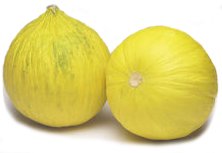
Melons are now largely grown in warm dry climates of the tropics and subtropics; warm humid climates are less suitable as melons are susceptible to foliage diseases and fruit quality is reduced. Spain produces most melons in Europe; France also has a flourishing industry, with further production in Italy, Israel and Greece, and smaller melon-growing areas in Kenya and North Africa. Melons are widely grown in Asia, largely for home consumption. In the US they are grown in the southern states, both east and west. Melons can be grown throughout the year in favourable climates, depending on choice of cultivar. Almost all melons are eaten fresh; there are minor uses for the fruits in yoghurt and as frozen melon balls. Flowers are, according to cultivar, either monoecious (staminate or pistillate) or andromonoecious (some staminate and some hermaphrodite); most American cultivars are andromonoecious and give a better set than European cultivars, which are usually monoecious. However, help with pollination is usually recommended, by introducing hives of bees in commercial crops, in the open or under glass. Hand pollination is recommended on a small scale. Hermaphrodite flowers produce round fruits; pistillate flowers elongated ones. Plants and flowers are killed by frost, and melons are hardly grown at altitiudes above 500m. Plastic tunnels may be used to protect plants from temperatures lower than optimum, either in the early stages or throughout the season. The best soils are well-drained fertile loams (pH 5.5-7.0), with a minimum depth of 40cm. In acid soils there is a risk of molybdenum deficiency. Lighter soils are used for earlier crops, but there is some loss of fruit quality. Soil preparation is started in the autumn before planting, with thorough cultivation to remove weeds, and also if necessary to incorporate manure, to maintain soil structure and improve moisture retention. The soil is allowed to settle before the final cultivation prior to sowing or planting. In some areas, melons are grown on ridges, and soil may be covered with a warming plastic mulch before sowing in rows or ridges. 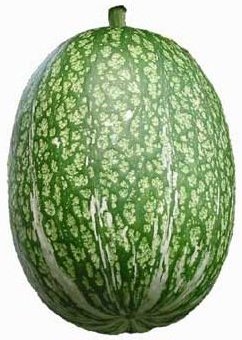
Seeds are sown 1.2-3.7cm deep in rows spaced at 1.2-2m or in hills 60-120cm apart. Plants may also be raised in pots or boxes under protection before transplanting when two or three true leaves have formed. The minimum soil temperature for germination is 15ºC and the optimum for seedling growth is about 30ºC. Plants sown in rows are thinned to 30cm apart, although precision sowing will eliminate this operation. In cooler climates young plants may be protected by individual tents of glassine or translucent paper or grown under low plastic tunnels. Generous amounts of organic material in the soil benefit melons, supplemented by a complete fertiliser before planting. Rates vary with soil type, water availability and type of culture. Weeds are controlled by shallow hoeing or chemical herbicides until the plants cover the ground, or by black plastic film laid as a mulch. Open-grown plants in the US are not stopped; regular picking allows fruiting to continue. In Europe, each grower has his own system. Water demand is high when plants are growing fast and fruits are swelling, but is reduced just before fruits start to mature. Trickle irrigation is commonly used in the open, as the most efficient system. Fruits which are allowed to ripen develop the best flavour, and picking is done at regular intervals to obtain fruits at the right stage. In most cultivars of the musk melon group this is when the fruit separates easily from the stem, which is called ‘full-slip’. Cantaloupes signal maturity by a change in rind colour and, in certain cultivars, by the development of a scent and of fine circular cracks at the base of the stem. In melons picked on hot days field heat must be removed as quickly as possible before sending to market. Some trials in California with picking at night have been successful in otaining cool fruit of the right quality. Mechanical harvesting has not been successful, although conveyor belts are often used to accelerate transport between field and packing shed. Storage is relatively short-term, and musk melons can be kept for six to twelve days at 3-4ºC (at relative humidity RH 85-90%). Honeydew melons can be kept longer; for 14-19 days since they have a hardier, less permeable rind at 10-15ºC. In colder climates, with a shorter frost-free period, melons are grown with protection for all or part of the season: they take 3-4 months to reach maturity, and warm dry conditions are essential for ripening. In France, where there are several climatic areas, different cultural systems are practised: in heated glasshouses in soil or soilless culture (vermiculite or perlite), in plastic tunnels (high or low) or in the open air (with or without irrigation). In northern Europe melons are still grown in gardens in small houses of glass or plastic. 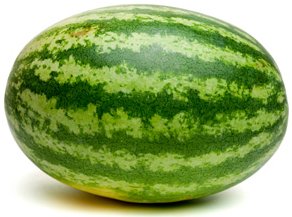
In greenhouses they may be grown in beds, or in raised troughs and boxes (30cm deep, 46cm wide), in a high-fertility loam-based medium with well-rotted manure; good basal drainage is essential. They can be grown all year round with heat, but the usual time for sowing is spring. Seeds are sown singly in pots or soil blocks, at a temperature of 13-15ºC. When true leaves appear, melons are transplanted in the greenhouse bed at 45-60cm apart along the side walls. When about 10-15cm tall the growing point is pinched out, which stimulates the production of two shoots, to be trained up wires on the side walls. A temperature of 16-27ºC is maintained with ventilation when temperatures rise above this. When each shoot has produced five leaves, the growing tip is again removed to stimulate side shoots on which the flowers are produced. When three leaves are produced on each of these side shoots the tips are pinched out. Six to eight flowers are selected on each plant and are hand pollinated: once they have set, four fruit of uniform size are selected (not more than one per lateral) for growing on, and the others removed. Plants should be kept well watered, and given a liquid weekly feed from the stage when the fruits are about the size of a walnut. Stop the fruit-bearing laterals at the first joint beyond the fruit when it begins to swell. As the fruits grow they need to be supported by nets tied to the wires. Leaves and laterals are thinned out as necessary. When the fruit has reached full size humidity levels are lowered for ripening; feeding is stopped and watering reduced to keeping the medium just moist to avoid rind splitting. Signs of ripening are as already described. Most will break cleanly from the vine; others, like honeydew melons, must be cut. For early crops, on hotbeds in frames, the growing medium must be of sufficient depth to maintain a temperature of about 18.5ºC. In frames, two plants are positioned in the centre of each frame and two shoots from each are led to the corners of the frame. When each shoot has produced 6-8 leaves the growing tips are cut back to four leaves. The side shoots thus stimulated are next stopped at three leaves and the flowers subsequently produced are hand-pollinated, eventually allowing two fruits to develop per plant for main crops, and one for early and late crops. A flat stone may be placed under each fruit to keep them clean and to aid uniform ripening. 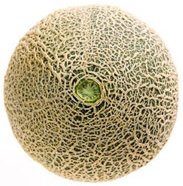
Recommended cultivars. Cantaloupe: ‘Charentais’, ‘Early Sweet’, ‘Sweetheart’ (good under glass in colder climates). Musk melons (netted or nutmeg melons); green-fleshed: ‘Emerald Gem’, ‘Gayla F1 Hybrid’, ‘Jenny Lind’, ‘Ogen’ (‘Haogen’), ‘Rocky Ford’, ‘Rocky Sweet’; salmon-fleshed: ‘Ambrosia’, ‘Banana’, ‘Burpee Hybrid’, ‘Hearts of Gold’, ‘Iroquois’, ‘Musketeer’ (bush); red-fleshed or orange-fleshed: ‘Blenheim Orange-Superlative’, ‘Minnesota Midget’ (very compact bush), ‘Resistant Joy N22 F1 Hybrid’ (very early); white-fleshed: ‘Gold Crispy’, ‘Hero of Lochinge’. Winter melons (late-ripening, can be stored); ‘Golden Beauty’ (Casaba type, rough-skinned). ‘Earli-Dew’, ‘Green Fleshed’, ‘Orange-fleshed’ (honey types). Others; ‘Sugar Baby’ (small, light green flesh), ‘Crenshaw’ (warm climate), ‘Early Crenshaw’ (very large), ‘Honeyshaw’ (very early), ‘Yellow Canary’. Melons are susceptible to collar-rot, hence mound and ridge cultivation is advised. A further precaution is to plant seedlings with soil balls emerging from the medium surface. Over watering in dry periods may cause splitting: wait until slight foliage wilt is apparent before watering. Other susceptibilities, common to all cucurbits, are to Botrytis cinerea, Erysiphe chichoracearum, bacterial canker (Bacterium carotovorum), leaf blotch (Cercospora melonis) and root rot (Fusarium vasinfectum, Verticillium alboatrum) and cucumber mosaic virus. Grafting on to a resistant rootstock is sometimes practised to prevent infection by root disease.
|
Home
Grow Herbs
Grow Nuts
Grow Vegetables
Cyberian Index
If you like this website and want one of your own contact
Cyberian All information correct at
time of publication and open to updates as necessary. No part of this website,
or its vectors, may be produced in any shape or form, using any type or design
of medium, system, equipment or otherwise without the prior written consensual
notice of the Cyberian. Any breach of these requirements will result in the
appropriate action. If in doubt, e-mail contact is recommended.
Some components of this website were obtained as open-source software and are
used in the same non-profit manner on this website.